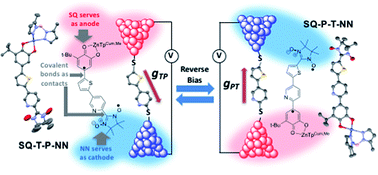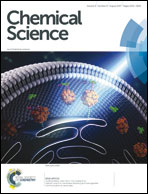Heterospin biradicals provide insight into molecular conductance and rectification†
Abstract
The correlation of electron transfer with molecular conductance (g: electron transport through single molecules) by Nitzan and others has contributed to a fundamental understanding of single-molecule electronic materials. When an unsymmetric, dipolar molecule spans two electrodes, the possibility exists for different conductance values at equal, but opposite electrode biases. In the device configuration, these molecules serve as rectifiers of the current and the efficiency of the device is given by the rectification ratio (RR = gforward/greverse). Experimental determination of the RR is challenging since the orientation of the rectifying molecule with respect to the electrodes and with respect to the electrode bias direction is difficult to establish. Thus, while two different values of g can be measured and a RR calculated, one cannot easily assign each conductance value as being aligned with or opposed to the molecular dipole, and calculations are often required to resolve the uncertainty. Herein, we describe the properties of two isomeric, triplet ground state biradical molecules that serve as constant-bias analogs of single-molecule electronic devices. Through established theoretical relationships between g and electronic coupling, H2, and between H2 and magnetic exchange coupling, J (g ∝ H2 ∝ J), we use the ratio of experimental J-values for our two isomers to calculate a RR for an unsymmetric bridge molecule with known geometry relative to the two radical fragments of the molecule and at a spectroscopically-defined potential bias. Our experimental results are compared with device transport calculations.



 Please wait while we load your content...
Please wait while we load your content...